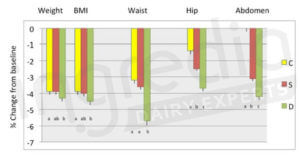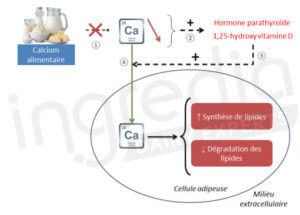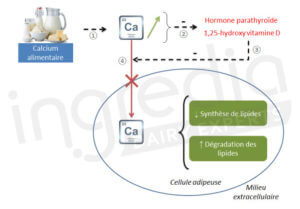The added interest of milk proteins for weight management
22 December 2021
As we already mentioned in our previous article “The interest of proteins in weigh management”, the WHO warns populations about the statistics on obesity: over 2 billion people are overweight in the world, and this number is growing every year. 1
We previously insisted on the interest of proteins for weight loss. But among all the protein sources all do not bring the same benefits. Milk proteins, for example, have particularly interesting features for weight management purposes.
How can milk protein be interesting for weight management?
These proteins are interesting for weight management for different reasons.
Proteins in general are very relevant for weight management. At a high concentration, they have an important satietogenic effect and they enhance thermogenesis and muscular mass gains.2 This is valid for all proteins at different levels, as described more precisely in the article “How can proteins be interesting in weight management?”.
Furthermore, there are two types of proteins in milk: whey proteins and micellar caseins; and the latter represents an important source of calcium, whose efficiency to enhance weight loss has been proven. 3 4

Has the efficiency of calcium to enhance weight loss been really proven?
Yes it has, many studies have shown this. We can take the example of a recent study of 2019 in which overweight people (BMI > 25kg/m²) have been put on an energy-restricted diet with moderate physical activity. They were divided into three groups: 5
- Group C was the control group;
- Group S had a supplementation of calcium (1,500mg) and vitamin D (10µg)
- Group D consumed 4 to 5 dairy products per day (in order to provide approximately the same amount of calcium and vitamin D than group S).
Results regarding weight loss are given on figure 1. The group D significantly presents the best results for the circumference of waist, hips and abdomen. However, with regards to the weight loss, the difference will initially seem less impressive. This is due to the fact that group C and S have lost more than only fat mass. After 6 months, group C has lost 2.1kg of lean mass, group S lost 1.7 kg, while group D only lost 1.0kg. Dairy products, a source of calcium, vitamin D and proteins (whey and micellar caseins) allowed a better retention of muscle mass and a more efficient fat loss.5

Figure 1: Percentage of changes concerning weight (kg), BMI (kg/m²), waist size (cm), hip size (cm), abdomen size (cm) after 6 months of the diet.5
C: control group (n=30) / S: supplement group (n=37) / D: dairy products group (n=30)
How can calcium enhance weight loss?
To understand this process, we need to detail certain aspects of calcium metabolism.
Calcium has an important role in fat cells. It has been shown that an increase of calcium concentration in these cells would increase fat accumulation (lipogenesis) and inhibit fat degradation (lipolysis).The calcium concentration in cells is regulated by parathyroid hormone and the active form of vitamin D (1,25-hydroxy vitamin D). This is described in figure. 2 6
The hormone activity is regulated by dietary calcium. As a matter of fact, it can suppress the activity of these hormones. Consequently, this could reduce the calcium entry in fat cells, thus significantly reducing fat accumulation while having the opposite effect of enhancing lipids degradation (figure 3). 6 7
In other words, increasing calcium consumption would limit fat storage and act as a natural fat burner. A 2003 study has shown that a high calcium diet could multiply fat degradation by an average of 3 to 5. 6 7

Figure 2: Effect a diet below calcium requirements on lipid metabolism
① Lack of dietary calcium in the extracellular environment
② Activation of the parathyroid hormone and the active form of vitamin D (1,25-hydroxy vitamin D).
③ Stimulation of calcium entry in fat cells
④ Calcium entry in fat cells which enhance fat synthesis and inhibit fat degradation

Figure 3: Effect of a diet high (greater than or equal to needs) in calcium on lipid metabolism
① Large amount of dietary calcium in the extracellular environment
② Inhibition of the parathyroid hormone and the active form of vitamin D (1,25-hydroxy vitamin D).
③ Inhibition of calcium entry in fat cells
④ The lack of calcium in fat cells enhance fat degradation and inhibit fat synthesis
Additionally, calcium can naturally limit fat absorption. This represents the second advantage of calcium for weight management. This phenomenon has been shown with micellar caseins through a study in 2015. During this study, overweight subjects had to consume a high fat meal with a portion of proteins. It could be caseins, classic whey or whey enriched in α-lactalbumine. Analyses have shown a significant average decrease of 22% of fat absorption with caseins. 8 A second study in 2001 has also shown that a consumption of calcium of 900mg/d could multiply lipid excretion by 2, and decrease LDL cholesterol concentration (commonly called “bad cholesterol”) by 15% after only 2 weeks of supplementation. 9
Moreover, calcium would, in the same way as proteins, increase thermogenesis and therefore increase energy expenditures. 2 10
Are micellar caseins more interesting than a calcium supplement?
Micronutrients (vitamins and minerals) found directly in food are generally better absorbed by the body than those provided in free form via a food supplement. Therefore, calcium from micellar caseins should be absorbed much better. 2 3 11 12 13
Furthermore, caseins represent a good calcium source with approximately 2,600mg/kg 14 , but also a very good source of interesting proteins for weight loss. It is better to combine the entire factors which enhance weight management rather than consider an isolated element, such as calcium alone. This was particularly highlighted in the previously cited 2019 study. 5
What about whey proteins? Is it of particular interest?
Yes, it is a particularly interesting protein for its short-term satietogenic effect. Compared to other protein sources, whey proteins are very efficient to quickly increase the feeling of fullness. Therefore, this favors the reduction of food intakes. 15 16
Furthermore, certain studies have observed a reduction of postprandial (after a meal) blood glucose when whey proteins are consumed before a high carbohydrates meal. This has been shown in a 2010 study in which one healthy subjects had consumed different amounts of whey before a meal (between 10 and 40g), after which blood glucose was measured. Then, authors noted that the more whey protein is consumed before meal, the least blood glucose was (maximal effect for 40g of whey proteins) 17. This can be very interesting; especially for people having difficulties in regulating their food intake or overweight subjects who want to reduce their energy consumption.
Therefore, micellar caseins or whey proteins can represent interesting proteins for weight management.
For more information, contact us.
Authors: Rémi Maleterre & Audrey Boulier.
_______________________________________________________________________________________________
[1] « Obesity and overweight». World Health Organization. WHO. February 16, 2018 [consulted: july 09, 2019]. https://www.who.int/news-room/fact-sheets/detail/obesity-and-overweight
[2] D. Paddon-Jones, E. Westman, R.D. Mattes, R.R. Wolfe, A. Astrup, M. Westerterp-Plantenga (2008). Protein, weight management, and satiety. The American Journal of Clinical Nutrition, Volume 87, Issue 5, May 2008, Pages 1558S–1561S. Pub May 01, 2008. https://doi.org/10.1093/ajcn/87.5.1558S
[3] S. Schrager (2005). Dietary Calcium intake and obesity. J Am Board Fam Pract. 18(3):205-10. Pub May 2005.
[4] M. Van Loan (2009). The role of dairy foods and dietary calcium in weight management. Journal of the American College of Nutrition. 28:supp1, 120S-129S. Epub June 14, 2013. https://doi.org/10.1080/07315724.2009.10719805
[5] J.Z. Ilich, O.J. Kelly, P.Y. Liu, H. Shin, Y. Kim, Y. Chi, K. Wickrama, I. Colic-Baric (2019). Role of Calcium and low-fat dairy foods in weight-loss outcomes revisited: results from the randomized trial of effects on bone and body composition / obese postmenopausal women. Nutrients 2019, 11(5), 1157. Epub May 23, 2019. https://doi.org/10.3390/nu11051157
[6] M.B. Zemel (2003) Mechanisms of dairy modulation of adiposity. J Nutr 2003;133:252S–6S. Pub January 2003. https://doi.org/10.1093/jn/133.1.252S
[7] M.B. Zemel (2002). Regulation of adiposity and obesity risk by dietary calcium: mechanisms and implications. J Am Coll Nutr 2002;21:146S–51S. Pub April 2002.
[8] F. Mariotti, M. Valette, C. Lopez, H. Fouillet, M.H. Famelart, V. Mathé, G. Airinei, R. Benamouziq, C. Gaudichon, D. Tomé, D. Tsikas, J.F. Huneau (2015) Casein compared with whey proteins affects the organization of dietary fat during digestion and attenuates the postprandial triglyceride response to a mixed high-fat meal in healthy, overweight men. J Nutr 145, 2657–2664. Pub December 2015. https://doi.org/10.3945jn.115.216812
[9] Y. Shahkalili, C. Murset, I. Meirim, E. Duruz, S. Guinchard, C. Cavadini, K. Acheson (2001) Calcium supplementation of chocolate: effect on cocoa butter digestibility and blood lipids in humans. Am J Clin Nutr 2001;73:246 –52. Pub February 2001. https://doi.org/10.1093/ajcn/73.2.246
[10] H. Shi, A.W. Norman, W.H. Okamura, M.B. Zemel (2001). 1alpha25-Dihydroxyvitamin D3 inhibits uncoupling protein 2 expression in human adipocytes. FASEB J 2002;16:1808 –10. Pub December 2001. https://doi.org/10.1096/fj.01-0584fje
[11] M. Zemel, W. Thompson, A. Milstead, K. Morris, P. Campbell (2004). Calcium and dairy acceleration of weight and fat loss during energy restriction in obese adults. Obes Res 2004;12:582–90. Pub April 2004. https://doi.org/10.1038/oby.2004.67
[12] Ingredia. Prodiet 87 B Fluid – Nutrition facts . December 11, 2015.
[13] B.L. Luhovyy, T. Akhavan, G.H. Anderson. (2007). Whey proteins in the regulation of food intake and satiety. Journal of the American College of Nutrition, Vol 26, Issue 6, p704S-712S. Epub June 14, 2013. https://doi.org/10.1080/07315724.2007.10719651
[14] S. Pal, S. Radavelli-Bagatini, M. Hagger, V. Ellis. (2014). Comparative effects of whey and casein proteins on satiety in overweight and obese individuals: a randomized controlled trial. European Journal of Clinical Nutrition. 68, 980-980. Epub May 07, 2014. https://doi.org/10.1038/ecjn.2014.84
[15] T. Akhavan, .L. Luhovyy, P.H. Brown, C.E. Cho, G.H. Anderson (2010). Effect of premeal consumption of whey protein and its hydrolysate on food intake and postmeal glycemia and insulin responses in young adults. The American Journal of Clinical Nutrition, Volume 91, Issue 4, April 2012, 966-975. Epub April 4, 201. https://doi.org/10.3945/acjn.2009.28406